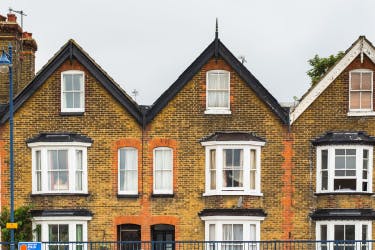Becoming a landlord: The essential guide to first time landlord mortgages
Are you thinking of renting out a property for the first time? Whether you’re renting a flat to complete strangers or buying an affordable home for your child to live in at university, here’s our guide to getting a mortgage as a first time landlord.
How to get a mortgage as a first time landlord
One of the first (and biggest) decisions you’ll need to make is what type of mortgage to get. Your mortgage can have a huge impact on the profitability of your investment, so it’s important to shop around and compare Buy to Let mortgage rates before submitting an application. We’ve covered the types of Buy to Let mortgages below:
Like any investment, becoming a landlord comes with risks. Your property may be vacant for periods of time (known as rental voids), which can impact your ability to cover mortgage payments. Property values can also fluctuate, meaning the value of your investment could go down as well as up. If you’re on a variable or tracker mortgage, rising interest rates could increase your monthly repayments.
Please note: Tax rules for Buy to Let landlords can change, potentially affecting your rental income and overall returns.
Standard Buy to Let
If you’d like to buy a property and rent it out to tenants, you’ll usually need a standard Buy to Let mortgage (unless you can afford to buy it in cash). To get a standard Buy to Let mortgage, you’ll usually need a deposit of at least 25% of the property’s value - higher than the traditional 10% or even 5% required for a standard residential mortgage.
How much you can borrow for a mortgage usually depends on the amount of rent you can expect to earn from the property, rather than your income - this is called interest coverage ratio. You’ll also need to meet the lender’s eligibility criteria, which may include having a good credit score and earning over a certain threshold.
Learn more: Buy to Let vs residential mortgage. What’s the difference?
Renting to your family
If you’d like to rent your property out to family members, you’ll need to get a Family Buy to Let mortgage. This is different from a standard Buy to Let in that it’s regulated by the Financial Conduct Authority (FCA), and normally has tighter requirements than a standard Buy to Let. Like with a standard Buy to Let, you’ll need to put down a larger deposit than if you were buying the same property through a standard residential mortgage.
In some cases, a new mortgage might not be necessary at all if you’re planning on renting out just a room in your home. The Rent a Room scheme lets you earn up to £7,500 per year tax-free from letting out furnished accommodation in your home. This is halved if you share the income with your partner or someone else.
Want to help your child get on the ladder?
If your son or daughter is struggling to buy a place of their own, there are ways you could help them buy sooner. At Tembo, we specialise in a range of family-assisted mortgages, including family Buy to Lets and guarantor schemes. Create a free Tembo plan with you and your child to see how you could help them make home happen.
Rent out your current home and move into a new one
If you’d like to move house without selling your existing property, a Let to Buy mortgage could be the answer. With Let to Buy, you’ll technically have two mortgages: one mortgage on the property you rent out and another on the new property you’ll live in.
Let to Buy is a popular option for those looking to earn a passive income from property, but it’s also suitable for homeowners who want to move house but are struggling to sell their current home aka ‘accidental landlords’.
To get a Let to Buy mortgage, you’ll usually need to have an idea of how much you’re able to charge tenants when letting out your current property. Lending criteria differs from one lender to another, but you may find it harder to get a Let to Buy mortgage if the amount of rent you can charge won’t cover your mortgage payments.
An experienced mortgage broker like Tembo can help you navigate these requirements and work out if a Let to Buy mortgage is right for you.
Read more: What is mortgage affordability and how does it work?
Protecting your tenants (and your investment)
You’ll have a number of responsibilities as a landlord, whether you’re renting your property to strangers or loved ones. For example, you’ll need to carry out regular safety checks (or hire a professional to do them for you) to reduce the risk of fire and other dangers. Here’s a quick breakdown of your main health and safety responsibilities. These measures can protect your tenants and help you avoid damage to your property and expensive consequences.
EPC rating
As of 1st April 2020, you can be fined £4,000 for providing a rental property that doesn’t achieve at least an Energy Performance Certificate (EPC) rating of E or above.
Each EPC is valid for ten years. Once you’ve bought a property, find out how long is left on the certificate. If it’s due to expire soon, you’ll need to pay for an inspection from an accredited assessor.
Gas safety
If the property has a gas supply, you’ll need to get a gas safety certificate each year. This can cost between £50 to £200 and must be provided by a tradesperson on the Gas Safe Register. You’ll need to give your tenants a copy of the certificate before they move in, and every time it’s renewed.
Electrical safety
You’ll also need to hire a qualified electrician to check the electrical installation of your property every 5 years. You’ll need to give a copy of the report to new and existing tenants.
Fire and appliance safety
You’re legally required to fit at least one smoke alarm on each storey of a property, but the exact type of alarm depends on whether you’re in England, Scotland or Wales.
You’re also responsible for ensuring that any electrical appliances such as washing machines and fridges are safe, and that all furniture and furnishings (except for curtains and carpets) comply with the 1988 Fire Safety regulations.
You don’t need to check tenants’ own appliances or furniture. When a tenant moves in, provide them with a thorough inventory listing all the appliances and furniture already provided. That way, if anything goes wrong, it’s clear which items belong to who.
Perfect for you: Is Buy to Let worth it in 2025?
Compare 20,000+ mortgages from over 100 lenders
We’ll compare more than 20,000 mortgages from over 100 lenders until we find the perfect Buy to Let mortgage for you. Whether you’re renting to strangers or loved ones, create a free Tembo plan today to find out how much you can borrow.




